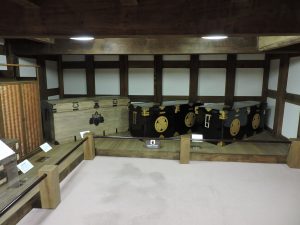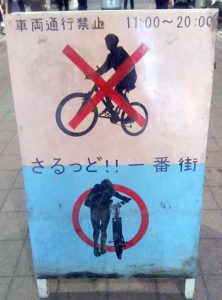[print-me]
和文は英文の下です / The Japanese translation with furigana is at the bottom of this page.

Contents
- Japanese was not one language
- The language created for “Modernization”
- The establishment of the Common Language in modern Japanese: the common grammar and vocabulary
- The limit of the Common Language: Its pronunciation varies from province to province
- Your Japanese and the nasal sound
- The nasal sound in modern Japanese
- Listening comprehension of the Japanese nasal sound
- [A game] Try a tongue twister containing the nasal sound
************************
1. Japanese was not one language
In our previous post, we said that you do not have to remember the rules of the nasal sound for announcers.
As the reasons, we have two:
(1) There is no problem in communication if you pronounce all the ga-row sounds with the regular “g”, and
(2) The set of rules applies to only one of the Tokyo dialects, which was adopted as the base of the Standard Language by the Meiji government. Since Japan’s industrial and commercial development during the 20th Century centered on Tokyo, people used to pay more attention to the rules of the Tokyo language. Now they don’t as much.
Along these lines, in this post, we will discuss what the Meiji government’s “Standard Language” was; how common people are using it now; and how the nasal sound is used today.
First, as background information, up until the end of the Edo Era (before 1867), there was no one integrated Japanese language since everyone spoke their own dialect.
2. The language created for “Modernization”
In the Meiji Era (1868-1912), the new government wanted to develop Japan into a nation of industry and commerce as in the West. In other words, they wanted to “modernize” Japan.
On the other hand, it was difficult to communicate with people from different parts of Japan since they kept speaking their dialects. Therefore, the government created a model language for people to learn. In doing this, they used one of the Tokyo dialects which had been spoken by the former warrior class.
They called it the Standard Language and had it taught at school for children from 1903. When radio broadcasting began in 1925, they had the announcers trained to speak the Standard Language so that all people in Japan could understand it.
Their efforts were so aggressive that they strongly suppressed people from speaking their dialects and local languages. As a result, some of them have become almost extinct.

3. The establishment of the Common Language: the common grammar and vocabulary
Today, the initial goal of the Meiji government has been attained; information by Japanese media including TV, the Internet, radio, newspaper and magazines, is published in only one language.
One can understand it if he/she was raised in a Japanese speaking family and learned Japanese during their mandatory education. It’s because a common understanding of the vocabulary and grammar has been established.
Since the second half of the 20th Century, this language has been called the Common Language.
You, as a foreigner, first learn this Common Language. That’s why, basically, you can communicate wherever you go.
4. The limit of the Common Language: its pronunciation varies from province to province
Now we have the common grammar and vocabulary, but what about pronunciation?
In fact, people still speak a mixture of their own dialect and the Common Language in their communities and with their family and friends. Using the same grammar, they also speak with the local accents and mix local vocabulary and expressions.
However, many of them consciously switch to the Common Language when they are at work, in customer service, when they talk to strangers or to people from other areas. In doing this, sometimes their accent is influenced by the local accents.
It means that even after decades of watching TV and listening to the radio, the announcers’ accents and pronunciation have not necessarily been adopted in people’s everyday life. When it comes to the nasal sound, some never notice the existence of it.
In summary, pronunciation and accents vary from province to province in Japan, but it is never a big problem in communication.
5. Your Japanese and the nasal sound
We presume that your textbooks teach the common language as well.
In terms of vocabulary and grammar, that’s just fine. As for the pronunciation, the two most important things at beginning and intermediate levels are:
(1) Pronounce vowels clearly.
(2) Pronounce each mora at an equal length.
After that, learn the correct accents and the flow in tones of the Common Language or of the language spoken in the area you live.
As for the nasal sound, you can think about it after learning all of the above. If you are busy, you don’t have to think about it.
6. The nasal sound in modern Japanese
By the way, the nasal sound is used in Japan in more varied ways than you may think.
There are areas where completely different sets of rules for the use of the regular “g” and the nasal exist; there are areas where people switch the regular “g” and nasal sound carelessly and for no particular reason; and in other areas, the nasal sound doesn’t exist at all.
Over all, it seems that there are fewer people who use the nasal. Even in Tokyo, fewer of the younger generations use it. Some say that in several decades, the nasal will disappear from the Japanese language.
The prospect that the smooth nasal sound will disappear causes some people to lament it. As we are from Tokyo, we will miss it, too, but Japanese is a language of long history. There have been many additions and disappearances in the past, and this may be just one of the changes.
7. Listening comprehension of the Japanese nasal sound
Back to present, the nasal sound is still often used. You may sometimes wonder while watching TV and videos, because a nasal does sound like the “n” sound. (For your information, we put a link to a video clip of a children’s folk song to show how it sounds, in [Mini Pocket (1) or the Japanese Nasal Sound].)
Usually you can easily tell what the speaker means by the context or from the situation. For example, you will not confuse “kagi” [with a nasal sound like “ka-ngi”] (key, lock) with “kani” (crab) because you generally don’t miss a crab in your purse or you don’t go to a seafood restaurant to eat a key.
That’s why the incident of my mistaking “mini pocket” for “mi-ngi pocket (the pocket on the right side)” was rather unusual.
8. (A game) Try a tongue twister containing the nasal sound
Lastly, let’s practice a popular hayakuchi kotoba or tongue twister. Try to say this first slowly, and then gradually faster.
> Nama-mugi, nama-gome, nama-tamago (Raw wheat, raw rice, raw egg)
Below are two links of videos of different people saying this:
First one is “Hachi-ji da yo, Zen-in Shuugoo” (It’s Eight, Let’s Get Together), a popular TV program of about 40 years ago. Surprisingly, all people here are saying this with the clean nasal sound although many are not from Tokyo.
However, when we compare videos demonstrating “nama-mugi, nama-gome, nama-tamago”, many more people say it with the regular “g” recently.
The second video is read by a woman with the regular “g” sound as well.
By the way, this children’s book titled “Namamugi Namagome Namatamago” is a collection of Japanese tongue twisters and very enjoyable. So we hope to introduce it to you here in the future.
Related Posts
- The Mini Pocket (1) or The Nasal Sound in Japanese
- The Mini Pocket (2) or The Rules in the Use of the Nasal Sound for Announcers
[End of the English post]

ミニポケットの話 最終回 鼻濁音と現代の日本語について
目 次
- 日本語はひとつではなかった
- 「近代化」のための言語
- 「共通語」の成立:文法と語彙は全国共通
- 「共通語」の限界:発音は各地方で異なる
- 自分の日本語と鼻濁音
- 現代日本語の鼻濁音
- 鼻濁音の聴き取り
- (遊び) 早口言葉
************************
1.日本語はひとつではなかった
前回の投稿で、皆さんはアナウンサーの鼻濁音のルールを覚える必要はないと申しました。
その理由として、次の二つを挙げたいと思います。
(1)日本語のガ行音をすべて普通の「g」で発音しても、意思疎通に全く違いがない。
(2)あのルールは明治政府が「標準語」の基とした東京方言特有のもの。20世紀には日本が東京を中心に発展したため、注目される度合いが高かった。今はそれほどではない。
これを受けて、この投稿では、明治時代の「標準語」とは何だったか。現在普通の人はこの言語をどのように使っているか、そして鼻濁音はどのように使われているか、考えてみたいと思います。
まず、江戸時代まで(1867年以前)の背景ですが、日本では誰もが方言を話していて、ひとつの「日本語」というものは存在しませんでした。
2. 「近代化」のための言語
明治時代(1868~1912)になると、新政府を作った人たちは、日本の工業・商業を西洋の国々のように発展させたいと考えました。別の言葉でいうと、近代化させたかった。
でも、みんなそれぞれの方言で話していたので、各地から集まった人々の意思疎通はなかなか困難でした。そのため、政府は模範とするためのモデル言語を作りました。基になったのは東京方言のひとつで、江戸の武家階級の使っていたものです。
政府はこの言語を「標準語」と呼び、1903年ごろから全国の学校で子どもたちに教えさせました。1925年にNHKのラジオ放送が始まったときは、アナウンサーを訓練して標準語で読ませ、日本中でこれが理解できるようにしました。
この言語教育は強力に推し進められ、逆に、どの地方でも方言の使用は厳しく抑圧されました。その結果、方言がほとんど消滅してしまった地域もあります。
3. 「共通語」の成立:文法と語彙は全国共通
今日、明治政府の当初の目的は達成されています。日本ではテレビも、インターネットも、ラジオも、新聞も、雑誌も、たったひとつの言語で情報を発信します。
日本語を話す家庭で育ち、義務教育で国語を学んだ人は理解できます。語彙と文法についての共通理解が成立しているからです。
そして、この言語は20世紀後半には「共通語」と呼ばれるようになりました。
外国人が日本語を習う時は、誰でも最初にこの「共通語」を習いますから、皆さんは基本的にどこへ行っても話が通じるのです。
4. 「共通語」の限界:発音は各地方で異なる
文法と語彙は全国共通になりましたが、発音はどうでしょうか。
実は、人々は家族、友人など自分の地元の人とは、今でも方言と共通語を混ぜて使います。文法は同じですが、アクセントは地元のアクセント、また、地元の語彙や表現が混じります。
いっぽう、仕事や接客の場、知らない人や他の地域から来た人への応対などにおいては、意識して共通語に切り替える人が多いです。このとき、アクセントは、地元のアクセントのままであることがあります。
つまり、何十年もテレビを見、ラジオを聞いていても、日常生活には、アナウンサーのアクセントや発音は必ずしも根付いてこなかったのです。鼻濁音に至っては、その存在にすらまったく気づかない人もいます。
要するに、発音やアクセントは、日本各地で異なります。でも、情報伝達において大きな問題が起こることはありません。
5. あなたの日本語と鼻濁音
皆さんの日本語の教科書も、共通語を教えていると思います。
語彙と文法に関しては本の通りでいいのですが、発音については、初級・中級の人にとって、まず大切なのは、次の二点です。
(1)母音をひとつひとつはっきり発音する。
(2)ひとつひとつのモーラを同じ長さで発音する。
次に、「共通語の」でも、「あなたの住む地域の」でもいいですから、正しいアクセントや言葉の流れを覚えるといいでしょう。
鼻濁音のことは、そのあと考えればいいけれど、忙しければ考えなくてもいいと思います。
6.現代日本語の鼻濁音
さて、鼻濁音は、意外にいろいろな形で日本語に存在しています。
普通の「g」 と鼻濁音が、共通語とは違うルールで使われる地方もあれば、「g」と鼻濁音をめいめいが好きなように使ったり使わなかったりする地方もあり、鼻濁音が存在しない地方もあります。
全体的には、使わない人の方が多くなっており、東京でも若い人は使わない傾向にあるようです。したがって、数十年で日本語から消滅するだろうと言われています。
このなめらかな鼻濁音がなくなることを嘆く人々もいます。私も東京出身なのでさびしい気もしますが、日本語は長い歴史のある言葉です。入ってきたものも、なくなったものもたくさんあるでしょう。これはそのひとつにすぎないのかもしれません。
7.鼻濁音の聴き取り
現在のところ、鼻濁音はまだまだ使われています。鼻濁音は「n」のように聞こえるので、テレビやビデオを見ているとき「あれ?」と思うこともあるかもしれません。(ご参考まで、鼻濁音がどのように聞こえるか、わらべ歌のビデオを聞いてみてください。=>ミニ・ポケット(1)または日本語の鼻濁音について)
でも、たいていは文脈や状況ですぐわかります。例えば、「かぎ(鍵)」 と「カニ(蟹)」はとても似ていますが、バッグの中でカニがなくなったとか、鍵を食べに海鮮料理の店へ行くとかいうことはないでしょう。
だから、私の「ミニポケット」と「右ポケット」の聞き間違いはちょっと珍しい出来事だったのです。
8. 早口言葉
ここで、早口言葉をひとつ。最初はゆっくり、だんだん早く言ってみてください。
> 「なまむぎ なまごめ なまたまご」
最後に、この早口言葉を言っているビデオを二つ置いておきます。
最初のは『8時だよ全員集合』という、40年ぐらい前の人気テレビ番組です。出演者は地方出身者も多いけれど、驚いたことに全員鼻濁音を使っています。
ところが、「生麦生米生卵」を言ってみせている他のビデオを聞き比べてみると、最近は普通の「g」を使う人の方がずっと多いのです。
二つめのビデオは『生麦生米生卵』という絵本の朗読ですが、やはり普通の「g」で読んでいます。
ところで、この本は早口言葉が集めてあってとても面白い。いずれ別の投稿でご紹介したいと思っています。
[和文部終わり]
関連リンク
=>Return to 2019 Posts / 2019年投稿記事へ戻る
=> Return to Home/「ホーム」へ戻る

